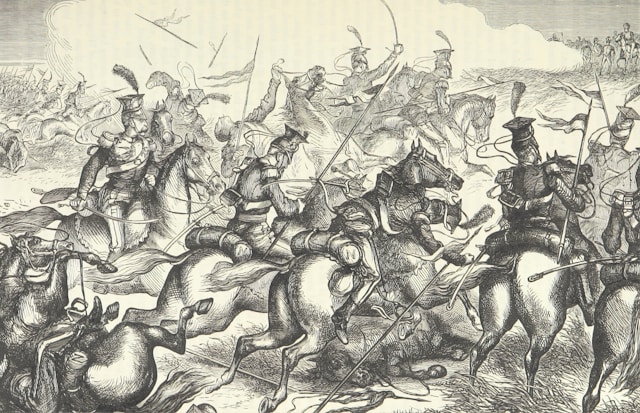Inhaltsübersicht anzeigen
Die battle of White Mountain, which took place on November 8, 1620, was a pivotal moment in the early phases of the Thirty Years’ War, a terrible and drawn-out war that devastated Europe from 1618 to 1648. This decisive battle changed the course of the Bohemian as well as the religious and political climate of Europe. The battle had far-reaching consequences for the area and the continent as a whole, culminating in a Catholic over protestant triumph.
Die battle of White Mountain, dubbed for the snow-covered slopes surrounding Prague, changed Europe’s religious and political landscape. The Catholic victory cemented Habsburg’s authority over Bohemia while paving the way for the counter-reformation to take root across Europe.
What truly transpired on that fateful day? How did an outnumbered and outgunned Catholic army overcome the protestants so decisively? Read on to learn how the Habsburg commanders, particularly General Tilly, outmanoeuvred and beat their opponents at every step in the White Mountain battle.
Introduction to the battle of White Mountain
The religious and political tensions that plagued the beginning of 17th-century Europe led to the battle of White Mountain.
The Holy Roman Empire, a confederation of Central European states, was central to these disputes. The Peace of Augsburg (1555) set a delicate balance, granting each ruler the right to decide whether his realm would be predominantly Catholic or Lutheran. This arrangement did not address the emergence of Calvinism or the resolution of the entrenched disputes between Catholic and Protestant groups.
A sour crisis arose in Bohemia because the staunch Protestant estates of the Bohemian aristocracy rejected King Ferdinand II, a Catholic who wanted to restore Catholic supremacy in Prague. Igniting the Bohemian Uprising in May 1618 was the Defenestration of Prague, in which Protestant rulers threw two of Ferdinand’s Catholic leaders out of a window.
Upon deposing Ferdinand, the rebels chose the protestant Frederick V of the Palatinate to be their king. This rebellion paved the way for the larger struggle known as the Thirty Years’ War.
Causes and prelude to the White Mountain battle
Die White Mountain battle resulted from decades-long religious and political strife. The protestant reformation, the breakup of the Holy Empire of Rome, and the immediate spark of the Defenestration von Prag all conspired to start the Bohemian revolt. The fight, marked by the Catholic league’s resounding triumph, laid the groundwork for subsequent wars and had far-reaching consequences for the Thirty Years’ War and Europe’s destiny. Here’s a brief overview of the causes and buildup to the battle of White Mountain:
Causes of the battle of White Mountain
Religious conflicts and reformation: Martin Luther’s 1517 protestant reformation split Europe’s religion into protestant groups.
Political unrest and power struggles: The empire comprised semi-autonomous states with regular power struggles between the emperor and princes
Succession crisis: After Emperor Matthias (1619) died, Ferdinand II, a Catholic, was elected to re-Catholicize the empire and consolidate his power, upsetting protestant lords.
Prelude to battle
Prague Defenestration (1618): protestant nobility, furious at Ferdinand’s religious restrictions, hurled two Catholic officials out a window, starting the Bohemian Revolt.
Protestant Union formation: protestant nobility overthrew Ferdinand and elected Calvinist Frederick V of the Palatinate as king of Bohemia, seeking backing from other protestant nations and foreign powers.
Military mobilization: The Catholic league backed Ferdinand II under Maximilian I of Bavaria and General Tilly, strengthening Catholic military power.
March to Prague: In October 1620, the Catholic league’s army marched to Prague to quash the Bohemian revolt, meeting at White Mountain.
The battle of White Mountain on 8.11.1620
Two troops fought on White Mountain outside Prague, Czech Republic, on 8 11, 1920. Motivated by the reformation, the protestants fought for religious freedom and against Catholic tyranny. However, the Catholic soldiers, led by the brutal General Tilly, attempted to destroy the protestant uprising and restore Catholic rule.
Both sides threw their might into the violent combat in hopes of winning. Count Tilly’s well-disciplined men rapidly defeated the protestants, who were outnumbered. Even though Frederick V’s troops tried hard, the Catholic Imperial troops were too strong.
Die protestant cause was devastated when the Catholics won the battle of White Mountain. Frederick V went into exile, and the Bohemian revolt was mercilessly crushed. As the Thirty Years’ War continued for another thirty years, the defeat at White Mountain began a long and difficult Catholic resurgence throughout Europe.
Consequences of the battle of White Mountain
Bohemia, Central Europe, and the Holy Roman Empire were all profoundly and far-reachingly affected by the battle of White Mountain, which took place on November 8, 1620. These are the main outcomes:
End of the uprising
The Bohemian revolt came to a close with the loss at White Mountain. After the Catholic armies captured Prague, Frederick V went into exile.
Repression
The Bohemian protestants were subject to harsh persecution by Ferdinand II, who ordered their murders, banished them from the country, and seized their property. Re-Catholization in Bohemia was imposed on the people.
Effects in the long run
Influencing the wider trajectory of the Thirty Years’ War and transforming Central Europe’s political and theological terrain, the triumph at White Mountain solidified Ferdinand II’s domination and the Catholic stance inside the Holy Roman Empire.
Legacy and commemoration of the battle of White Mountain
Die battle of White Mountain was a terrible and crucial European event. It showed how volatile and catastrophic early modern religious and political disputes were. The conflict marked the end of Czech independence and the start of Habsburg rule.
Monuments, memorials, and educational initiatives commemorate the fight. Historical studies and cultural activities encourage public reflection on its legacy.
White Mountain illustrates the connection of local and continental struggles in the Thirty Years’ War. The battle’s end affected Bohemia and Europe’s power balance. It showed how fragile alliances are and how military battles shape Geschichte.





